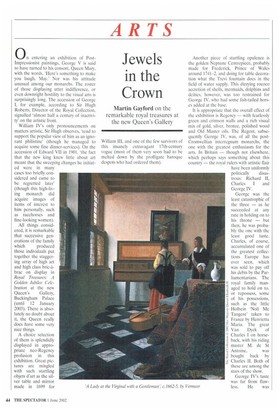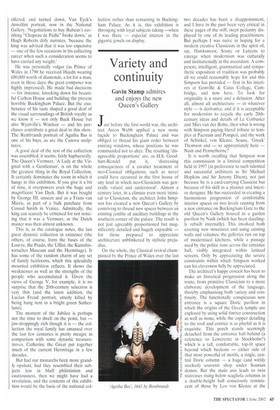Jewels in the Crown
Martin Gaylord on the remarkable royal treasures at the new Queen's Gallery
n entering an exhibition of PostImpressionist paintings, George V is said to have turned to his consort, Queen Mary, with the words, 'Here's something to make you laugh. May.' Nor was his attitude unusual among our monarchs. The roster of those displaying utter indifference, or even downright hostility to the visual arts is surprisingly long. The accession of George I, for example, according to Sir Hugh Roberts, Director of the Royal Collection, signalled 'almost half a century of inactivity' on the artistic front.
All things considered, it is remarkable that successive generations of the family which produced those individuals put together the staggering array of high art and high class bric-abrac on display in Royal Treasures: A Golden Jubilee Celebration at the new Queen's Gallery, Buckingham Palace (until 12 January 2003). There is absolutely no doubt about it, the Queen really does have some very nice things.
A choice selection of them is splendidly displayed in appropriate neo-Regency profusion in this exhibition. Great pictures are mingled with such startling objets d'art as the silver table and mirror made in 1699 for William III, and one of the few survivors of this insanely extravagant 17th-century vogue (most of them very soon had to be melted down by the profligate baroque despots who had ordered them). Another piece of startling opulence is the golden Neptune Centrepiece, probably made for Frederick, Prince of Wales around 1741-2, and doing for table decoration what the Trevi fountain does in the field of water supply. This dizzying rococo accretion of shells, mermaids, dolphins and deities, however, was too restrained for George IV, who had some fish-tailed horses added at the base.
It is appropriate that the overall effect of the exhibition is Regency — with fearlessly green and crimson walls and a rich visual mix of gold, silver, bronze, polished wood and Old Master oils. The Regent. subsequently George IV, was, of all the postCromwellian interregnum monarchs, the one with the greatest enthusiasm for the arts. In Britain — though not elsewhere, which perhaps says something about this country — the royal rulers with artistic flair have been uniformly
politically disastrous: Richard II, Charles I and George IV.
George was the least catastrophic of the three — as he succeeded at any rate in holding on to his throne — but then, he was probably the one with the least good taste. Charles, of course, accumulated one of the greatest collections Europe has ever seen, which was sold to pay off his debts by the Parliamentarians. The royal family managed to hold on to, or repossess, some of his possessions, such as the little Holbein 'Noli Me Tangere' taken to France by Henrietta Maria. The great Van Dyck of Charles 1 on horseback, with his riding master M. de St Antoine, was bought back by Charles II. Both of these are among the stars of the show.
George IV's taste was far from flaw less. He was offered, and turned down, Van Eyck's Arnolfini portrait, now in the National Gallery. 'Negotiations to buy Rubens's ravishing "Chapeau de Paille" broke down,' as Hugh Roberts drily narrates, 'because the king was advised that it was too expensive — one of the few occasions in his collecting career when such a consideration seems to have carried any weight.'
He was personally vulgar (as Prince of Wales in 1790 he received Haydn wearing £.80,000 worth of diamonds, a lot for a man, even in those days; the great composer was highly impressed). He made bad decisions — for instance, knocking down his beautiful Canton House and building the present horrible Buckingham Palace. But the exuberance of his taste shaped a good deal of the visual surroundings of British royalty as we know it — not only Buck House but also Vv'yatville's Windsor — and his purchases contribute a great deal to this show. The Rembrandt portrait of Agatha Bas is one of his buys, as are the Canova sculptures.
A good deal of the rest of the collection was assembled, it seems, fairly haphazardly. The Queen's Vermeer, 'A Lady at the Virginal with a Gentleman', is on the whole the greatest thing in the Royal Collection. It certainly dominates the room in which it hangs in this exhibition. If you give it a bit of time, it overpowers even the huge and magnificent Van Dyck. But it was bought by George III, unseen and as a Frans van Miens, as part of a bulk purchase from Consul Smith in Venice. Admittedly, the king can scarcely be criticised for not noticing that it was a Vermeer, as the Dutch master was then almost unknown.
This is, as the catalogue notes, the last great dynastic collection in existence (the others, of course, form the bases of the Louvre, the Prado, the Uffizi, the Kunsthistorisches Museum and the Hermitage). It has some of the random charm of any set of family heirlooms, which this splendidly mounted exhibition reflects. It shows the weaknesses as well as the strengths of the people who accumulated it. Given the views of George V, for example, it is no surprise that the 20th-century selection is very thin (and the latest addition, the Lucian Freud portrait, utterly killed by being hung next to a bright green Sutherland).
The moment of the Jubilee is perhaps not the time to dwell on the point, but — jaw-droppingly rich though it is — the collection the royal family has amassed over the last few centuries is pretty meagre in comparison with some dynastic treasuretroves. Catherine the Great put together much of the current Hermitage in a few decades.
But had our monarchs been more grandly opulent, had they resembled their subjects less in bluff philistinism and cautiousness, then we might have had a revolution, and the contents of this exhibition would be the basis of the national col
lection rather than remaining in Buckingham Palace. As it is, this exhibition is thronging with loyal subjects taking —when I was there — especial interest in the gigantic jewels on display.







































































 Previous page
Previous page